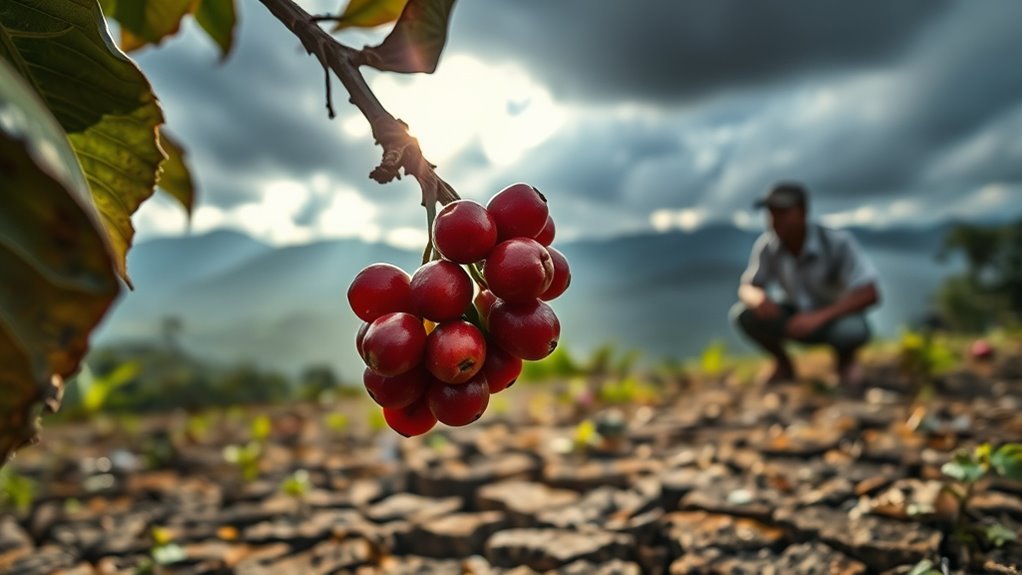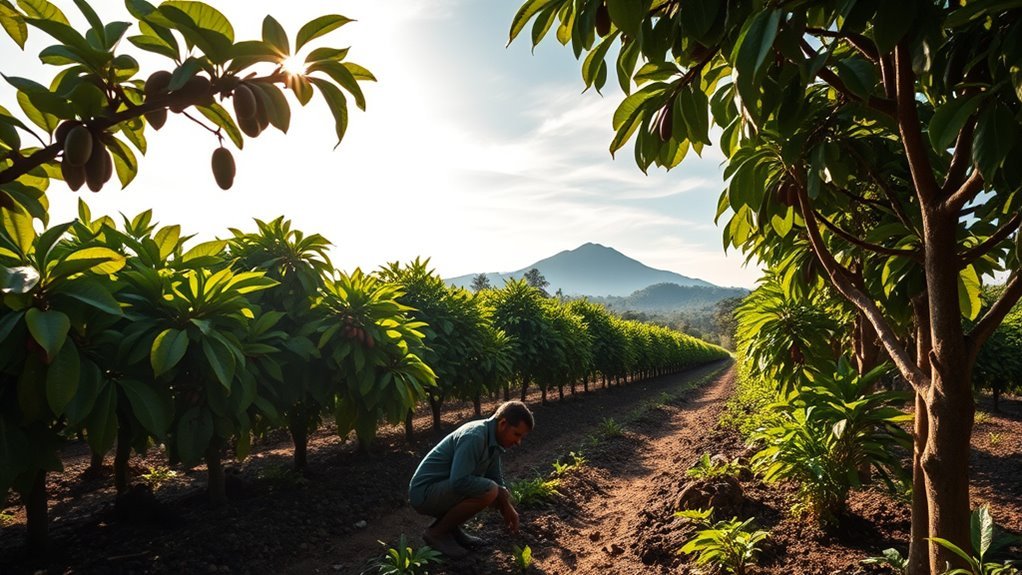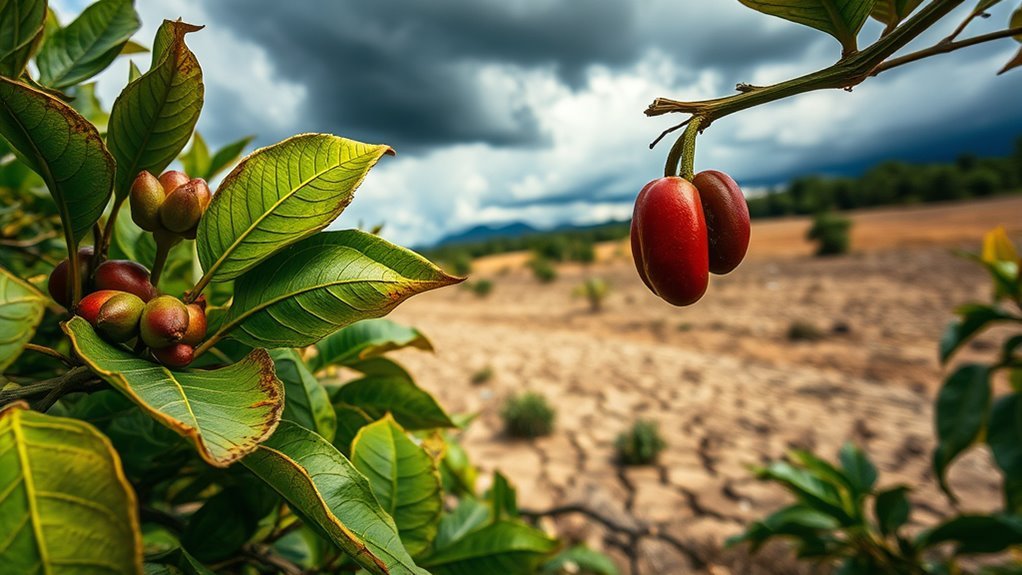The Impact of Climate Change on Coffee Production
Climate change disrupts your coffee production through unpredictable rainfall, elevated temperatures surpassing the ideal 18–23°C range, and increased pest threats like the coffee berry borer expanding into new altitudes. These factors reduce yield, degrade soil, and alter flavor profiles by impairing photosynthesis and biochemical processes. Socioeconomic impacts include income instability and increased poverty risks for farmers. To stay ahead, understanding adaptive farming techniques and sustainable innovations becomes essential, offering strategic responses that safeguard coffee’s future.
Changing Climate Patterns Affecting Coffee Growing Regions

Although coffee has traditionally thrived within specific climatic zones, shifting temperature and precipitation patterns are disrupting these ideal conditions. You’ll notice that climate resilience is becoming critical as traditional coffee-growing regions face irregular rainfall and extended droughts. These changes reduce suitable land area, forcing producers to reconsider their cultivation methods. Agroforestry systems offer a viable adaptation strategy by integrating shade trees, which moderate microclimates and enhance moisture retention. This approach not only buffers coffee plants against climatic stressors but also promotes biodiversity and soil health. As you evaluate coffee production’s future, understanding how altered climate variables reshape growing regions will empower you to advocate for sustainable, resilient practices that maintain yield and quality despite environmental uncertainty.
Effects of Rising Temperatures on Coffee Plants
As temperatures continue to rise, coffee plants experience significant physiological stress that directly impacts growth and yield. You’ll notice that exceeding ideal temperature thresholds (18–23°C) reduces photosynthesis efficiency and accelerates berry maturation, compromising quality. Plant resilience varies by species; Arabica is more sensitive than Robusta. Understanding these dynamics helps you anticipate shifts in viable cultivation zones.
| Temperature (°C) | Plant Response | Resilience Level |
|---|---|---|
| <18 | Slow growth | High |
| 18–23 | Ideal photosynthesis | High |
| 24–27 | Mild stress | Moderate |
| 28–30 | Reduced yield | Low |
| >30 | Severe stress/death | Very low |
Increased Pest and Disease Threats in Coffee Cultivation
You’re likely aware that rising temperatures create favorable conditions for pest populations to expand, directly impacting coffee crops. This escalation not only increases pest density but also accelerates the spread of diseases like coffee leaf rust and coffee berry disease. Understanding these dynamics is essential for developing effective management strategies in coffee cultivation.
Rising Pest Populations
When temperatures rise and humidity patterns shift, coffee plants become increasingly vulnerable to a range of pests and diseases that thrive under these altered conditions. You’ll notice that populations of key pests, such as the coffee berry borer, expand into higher altitudes previously unsuitable for their survival. This geographic shift challenges traditional pest resistance strategies, demanding adaptive management. Relying solely on chemical controls risks accelerating resistance, so integrating biological control agents—like predatory insects or entomopathogenic fungi—offers a sustainable alternative. These methods help restore ecological balance and mitigate pest outbreaks without compromising your freedom to manage crops naturally. However, effective implementation requires precise monitoring and understanding of pest population dynamics, emphasizing the need for data-driven, flexible approaches to safeguard coffee yields amidst evolving climatic pressures.
Disease Spread Acceleration
Although rising temperatures and shifting humidity directly influence pest populations, they also accelerate the spread of diseases affecting coffee plants. You’ll notice that warmer, wetter conditions create ideal environments for pathogens, facilitating faster pathogen evolution and increasing infection rates. This rapid evolution challenges existing disease resistance in coffee cultivars, rendering traditional control methods less effective over time. As disease agents adapt, you must reassess your management strategies to maintain crop health and yield. Monitoring pathogen genetic variation becomes essential to anticipate resistance breakdowns and to guide breeding programs focused on durable disease resistance. Without proactive adaptation, the combined pressure from pests and evolving pathogens threatens your coffee production’s sustainability, demanding integrated approaches that consider climate-driven shifts in disease dynamics.
Impact on Coffee Yield and Quality
You’ll notice that climate variability leads to significant fluctuations in coffee yield due to altered flowering and fruiting cycles. Additionally, shifts in temperature and precipitation patterns directly affect the biochemical processes that determine the coffee bean’s flavor profile. Understanding these impacts is essential for predicting production outcomes and maintaining quality standards.
Yield Fluctuations
Since climate change alters temperature and precipitation patterns, coffee yields have become increasingly unpredictable, challenging producers worldwide. You’ll notice that yield variability has intensified, driven by irregular rainfall and temperature extremes disrupting flowering and fruit development phases. Research shows that even slight deviations in microclimate conditions can reduce yield stability, compromising crop reliability. To maintain climate resilience, you must adopt adaptive strategies such as selecting drought-tolerant cultivars or optimizing shade management to buffer environmental stress. Precision agriculture tools can also help monitor microclimate fluctuations, enabling timely interventions. Ultimately, understanding and managing yield fluctuations is essential if you want to safeguard productivity and economic viability in an era where climatic uncertainty is the norm, not the exception.
Flavor Profile Changes
When shifting climate conditions alter temperature and humidity, they directly affect the biochemical compounds responsible for coffee’s flavor profile. You’ll notice that as these environmental variables fluctuate, the metabolic pathways in coffee cherries adjust, leading to variations in sugars, acids, and phenolic compounds. This results in diminished flavor diversity, limiting the range of taste notes that coffee can express. Additionally, increased temperatures often reduce aroma intensity by impacting volatile organic compounds vital for the coffee’s sensory appeal. Scientific analyses reveal that ideal growing conditions maintain a balance essential for preserving complex flavor molecules. If climate change continues unchecked, you’ll encounter coffee crops with less nuanced flavors and weaker aromas, challenging your freedom to enjoy the rich sensory experiences that high-quality coffee traditionally offers.
Socioeconomic Consequences for Coffee Farmers
Although climate change directly affects coffee yields and quality, its socioeconomic consequences for farmers are equally significant. You face increased economic instability as unpredictable weather patterns disrupt harvest cycles, reducing income consistency. This volatility undermines your ability to plan financially, impacting household welfare and community stability. Fair trade initiatives can offer some buffer by guaranteeing minimum prices, but they don’t fully offset losses caused by lower yields and quality degradation. Additionally, shifting cultivation zones force you to contemplate relocating or diversifying crops, which requires capital and knowledge you might not have. These pressures exacerbate poverty risks and limit your economic freedom. Understanding these dynamics is vital for policymakers and stakeholders aiming to support your resilience amid climate-induced challenges without compromising your autonomy.
Adaptation Strategies in Coffee Farming

As climate change reshapes environmental conditions, you must adopt targeted adaptation strategies to sustain coffee production. Implementing shade management helps moderate temperature and retains soil moisture, vital under fluctuating climates. Soil conservation techniques, like contour planting and mulching, reduce erosion and maintain fertility. Incorporating organic practices enhances soil health, fostering resilience against pests and diseases. Efficient irrigation techniques optimize water use, significant as rainfall patterns become unpredictable.
| Strategy | Key Benefit |
|---|---|
| Shade Management | Temperature regulation, moisture retention |
| Soil Conservation | Erosion control, nutrient preservation |
| Irrigation Techniques | Water efficiency, drought mitigation |
Innovations and Sustainable Practices in Coffee Production
Innovations in coffee production are crucial to address the complex challenges posed by climate change and market demands. You’ll find sustainable farming techniques, such as precision irrigation and soil enhancement, are key for maintaining yield and quality under shifting climatic conditions. Coffee agroforestry, integrating shade trees within plantations, not only improves microclimates but also enhances biodiversity and carbon sequestration. This method mitigates temperature extremes and conserves soil moisture, essential for plant resilience. Additionally, genetic advancements are enabling the development of climate-resilient coffee varieties, reducing vulnerability to pests and diseases. By adopting these evidence-based practices, you guarantee a balance between productivity and ecological integrity. Embracing such innovations grants you the freedom to secure coffee’s future sustainably, aligning environmental stewardship with evolving market expectations.
Frequently Asked Questions
How Does Climate Change Affect Coffee Prices Globally?
You’ll notice coffee market fluctuations intensify as climate change disrupts growing conditions, reducing yields and quality. This scarcity drives prices upward globally. However, adopting climate adaptation strategies, like shade-grown coffee or drought-resistant varieties, can stabilize supply and moderate price volatility. By understanding these dynamics, you’re better equipped to anticipate market shifts, ensuring your decisions align with evolving environmental and economic realities in the coffee industry.
What Role Do Consumers Play in Supporting Climate-Resilient Coffee?
You play an essential role in supporting climate-resilient coffee by prioritizing sustainable consumption and ethical sourcing. By choosing coffees certified for environmental and social standards, you encourage producers to adopt adaptive farming practices and reduce ecological impact. Evidence shows consumer demand drives market shifts, promoting resilience in coffee systems. Your informed purchasing power fosters a supply chain that values long-term stability, empowering farmers to navigate climate challenges while maintaining freedom in their livelihoods.
Are There Specific Coffee Varieties More Resistant to Climate Change?
You might be surprised to learn that not all coffee plants handle stress equally. Varietal resilience varies widely due to genetic diversity within coffee species. Some Arabica cultivars, like Castillo and Catimor, show enhanced tolerance to heat and disease, thanks to selective breeding. By understanding these genetic traits, you can appreciate how certain varieties offer a buffer against climate fluctuations, granting you more freedom to enjoy coffee without fearing supply disruptions.
How Does Climate Change Impact Coffee-Related Employment Opportunities?
You’ll notice employment shifts as climate change alters coffee-growing conditions, causing labor demands to fluctuate seasonally. With unpredictable weather patterns, harvesting seasons may shorten or extend, impacting job availability and stability. These seasonal fluctuations can lead to inconsistent income for workers, especially in regions heavily reliant on coffee farming. Understanding these technical dynamics helps you appreciate how climate variability directly affects labor markets, challenging traditional employment structures in agricultural communities.
What Policies Support Sustainable Coffee Farming Under Climate Change?
You’ll find that effective policies promoting sustainable practices often include financial support and technical assistance to farmers adopting eco-friendly methods. Policy incentives like subsidies for shade-grown coffee and grants for water-efficient technologies encourage resilience against environmental stressors. Evidence shows these measures enhance yield stability and biodiversity. By leveraging such policies, you can foster a coffee sector that balances productivity with ecological health, granting farmers greater autonomy in managing climate risks.






